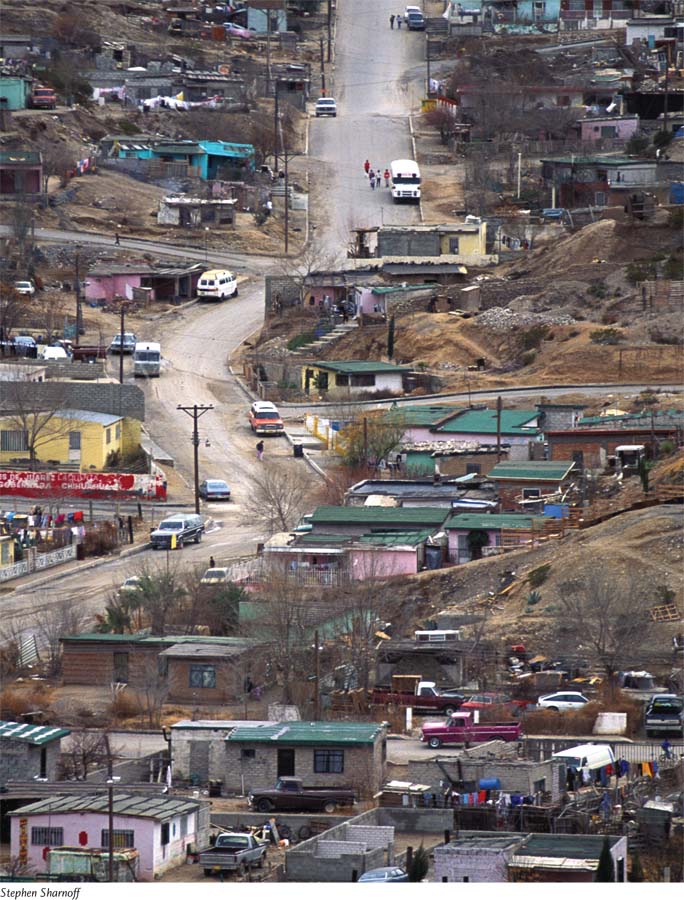Chapter Introduction
chapter 20
Sustainability, Economics, and Equity

Assembly Plants, Free Trade, and Sustainable Systems
Although citizens of Ciudad Juárez, Mexico, call the border with the United States la línea, or “the line,” the border, which stretches nearly 3,200 ksm (2,000 miles), is more a network of passageways than a division. Trade among people and cultures across this international boundary clearly affects both countries. The link between the Mexican and American economies, strengthened by globalization and increased trade, is exemplified by the maquiladora, or assembly plant, industry.
If we could give equal attention to economic profit, environmental integrity, and human welfare, could we ultimately create more sustainable development?
Established in the 1960s, this industry allows international companies to import materials and equipment free of tariffs to Mexican maquiladoras, and then to export the finished product to markets in other countries. In 1994, the United States, Canada, and Mexico passed the North American Free Trade Agreement (NAFTA), which was intended to increase trade among the three countries by reducing tariffs and other taxes as well as regulations. After NAFTA, the use of maquiladoras increased significantly, with the export of assembled products tripling between 1995 and 2000. Maquiladoras, which export 90 percent of their products to the United States, currently constitute 80 percent of the economy in the northern border region and a quarter of Mexico’s total GDP. And while the jobs have been welcomed in these economically depressed areas, there have been many negative consequences as well, including industrial pollution, poor working conditions, and discrimination. In addition, the maquiladoras raise questions of social justice because much of the profit is sent to other countries.
In terms of the environment, maquiladora operations often contaminate the border region with toxic industrial waste. Environmental regulations are lenient or nonexistent, and the majority of companies do not comply with mandates that maquiladora waste be shipped to the company’s home country. Disposal of toxic chemicals and heavy metals into the local environment causes groundwater and surface water pollution and significant harm to human health. Many maquiladora employees are women of reproductive age, a population that is particularly vulnerable to toxic chemicals.
In addition to pollution from the manufacturing processes, an increase in the human population in maquiladora areas has added greatly to other environmental problems. Many municipalities in which maquiladoras are situated do not have sewage treatment facilities or trash collection capabilities. The solid waste pollutes water sources, and seasonal floods spread garbage throughout the areas.
Social abuses also occur in this system. Employers often test women for pregnancy before they are hired, and those who become pregnant may be illegally fired. Managers employ underage workers. Factory conditions are hazardous, and employees are often unaware of risks because of the lack of “right to know” laws and an absence of warning signs in Spanish. Companies exploit the poverty of the region by offering wages that barely support employee needs. An average maquiladora worker earns the equivalent of a few dollars per day, and these wages have remained stagnant for years even as living costs have risen.
Sometimes the profits from these factories do not enter the Mexican economy, but rather go to the home countries of the companies that run the plants. Many observers believe that northern Mexico pays the social and environmental prices for the maquiladora industry, while foreign corporations reap the benefits.
Free trade and globalization agreements like NAFTA are designed to enhance developing economies by facilitating international business. However, in northern Mexico, increased free trade has stimulated an industry that in some cases may sacrifice social well-
Sources: J. Carrillo and R. Zarate, The evolution of maquiladora best practices: 1965–
Throughout this book we have seen that economic development, social justice, and sustainable environmental practices are often in conflict. In recent years, environmental scientists have begun to address these relationships by using the tools from economics and other fields to help find ways in which we can achieve a sustainable, equitable, and prosperous existence for all inhabitants on Earth. However, it is difficult to expect people to be concerned about the welfare of the planet on which they live if they have not met their own basic needs of water, food, health, and housing. Thus in recent years, environmental well-